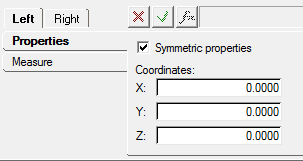The following types of entities are used in MotionView models:
Control Entities
Geometric Entities
Physical Entities
| • | Coil spring/Torsion spring |
|
Reference Entities
User-Defined Entities
|
Entity Properties
|
The attributes of an entity are called properties. The properties of a point entity are the X coordinate, Y coordinate, and Z coordinate. Body entities have mass and inertia properties. A property can be a simple scalar value or it can be a mathematical expression that makes a property a function of other properties in the model.
|
Entity Pairs
|
MotionView can store entities as pairs and provides tools for managing symmetry. Each side of a symmetric model is separately maintained to avoid having to build one half of a model and mirror it to create a full model. Symmetry is turned on or off using the Symmetric Properties option.

Points panel - Symmetric Properties option
When two entities are stored as a pair, one is called the left entity and the other is called the right entity. By default, paired entities are symmetric and the left side is the master. Symmetry can be disabled for any entity pair. When symmetry is on, only the master side can be edited, and changes to the master side are automatically made to the corresponding entity.
|
See Also:
Adding and Removing Entities
Activating and Deactivating Model Entities







